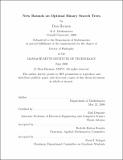New bounds on optimal binary search trees
Author(s)
Harmon, Dion (Dion Kane)
DownloadFull printable version (911.0Kb)
Alternative title
New bounds on optimal BSTs trees
Other Contributors
Massachusetts Institute of Technology. Dept. of Mathematics.
Advisor
Erik Demaine.
Terms of use
Metadata
Show full item recordAbstract
Binary search trees (BSTs) are a class of simple data structures used to store and access keys from an ordered set. They have been around for about half a century. Despite their ubiquitous use in practical programs, surprisingly little is known about their optimal performance. No polynomial time algorithm is known to compute the best BST for a given sequence of key accesses, and before our work, no o(log n)-competitive online BST data structures were known to exist. In this thesis, we describe tango trees, a novel O(log log n)-competitive BST algorithm. We also describe a new geometric problem equivalent to computing optimal offline BSTs that gives a number of interesting results. A greedy algorithm for the geometric problem is shown to be equivalent to an offline BST algorithm posed by Munro in 2000. We give evidence that suggests Munro's algorithm is dynamically optimal, and strongly suggests it can be made online. The geometric model also lets us prove that a linear access algorithm described by Munro in 2000 is optimal within a constant factor. Finally, we use the geometric model to describe a new class of lower bounds that includes both of the major earlier lower bounds for the performance of offline BSTs, and construct an optimal bound in this new class.
Description
Thesis (Ph. D.)--Massachusetts Institute of Technology, Dept. of Mathematics, 2006. This electronic version was submitted by the student author. The certified thesis is available in the Institute Archives and Special Collections. Includes bibliographical references (p. 153-156).
Date issued
2006Department
Massachusetts Institute of Technology. Department of MathematicsPublisher
Massachusetts Institute of Technology
Keywords
Mathematics.